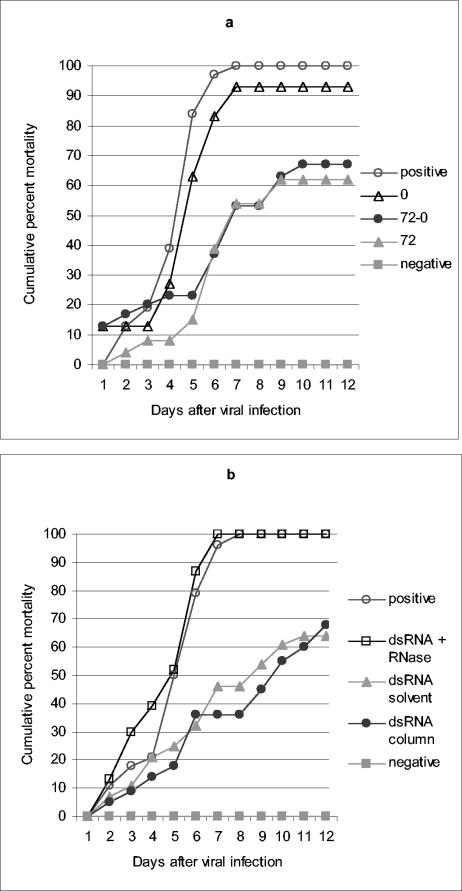FIG. 2.
Induction of the antiviral state is due to RNA. Shrimp (2 to 3 g) were injected intramuscularly with either saline (positive [○] and negative [░⃞] controls) or dsRNA. At 72 h after this initial injection, animals were infected with WSSV either alone or mixed with dsRNA. (a) Animals (n = 26 to 31) were injected each time with 50 μl of a solution containing ca. 10 to 15 μg of dsRNA for duck υ and challenged with WSSV-positive extract. The 72-0 group (•) received dsRNA both 72 and 0 h (coinjection) before viral infection, the 72 group (gray triangles) received dsRNA only 72 h prior to infection, and the 0 group (▵) received dsRNA only mixed with the WSSV inoculum. (b) Shrimp (n = 20 to 28) were kept in a recirculation system (see Materials and Methods), injected with dsRNA 72 h before viral challenge, and then reinjected with dsRNA mixed with WSSV-positive extract. Positive (○) and negative (░⃞) controls were as described for panel a. dsRNA for the duck υ was used in every case and applied at 10 to 15 μg per injection. dsRNA was purified with phenol and chloroform (gray triangles), RNeasy columns (Qiagen) (•), or purified with RNeasy columns and treated with a cocktail of RNases (RNase A, RNase T1, and RNase V1 from Ambion) (□). The Fisher exact test was used to assess the significance of the observed antiviral protection by comparing the final cumulative mortality in dsRNA-treated groups with that of their respective positive controls: (a) 72-0 treatment (P = 0.0003) and 72 treatment (P = 0.0001) and (b) dsRNA column (P = 0.0017) and dsRNA solvent (P = 0.0003).

